MXA RACE TEST: THE REAL TEST OF THE 2025 KAWASAKI KX250
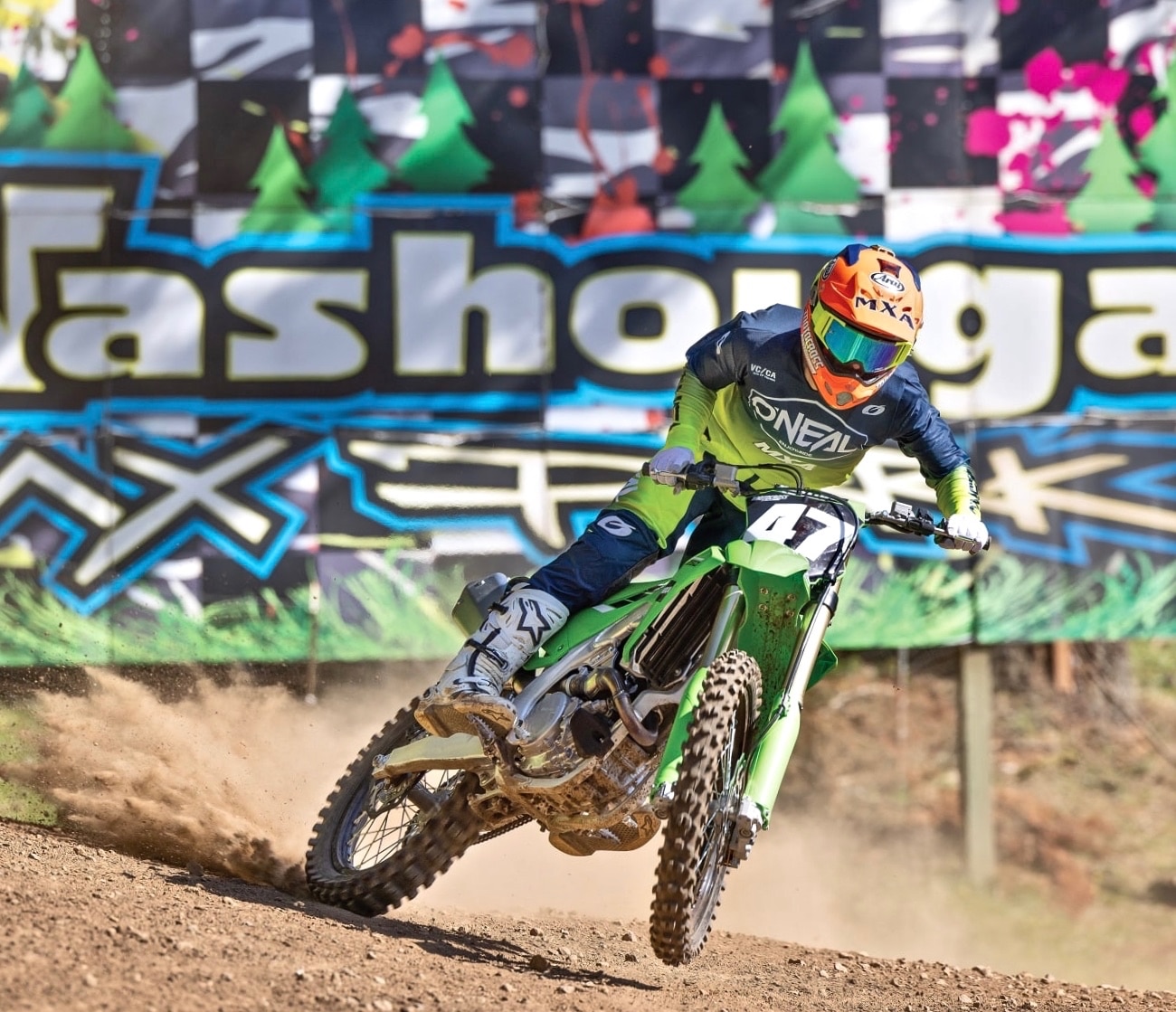 THE GEAR: Jersey: O’Neal Mayhem, Pants: O’Neal Mayhem, Helmet: Arai VX-Pro4, Goggles: Viral Brand Signature series, Boots: Alpinestars Tech 10.
THE GEAR: Jersey: O’Neal Mayhem, Pants: O’Neal Mayhem, Helmet: Arai VX-Pro4, Goggles: Viral Brand Signature series, Boots: Alpinestars Tech 10.
Q: FIRST AND FOREMOST, IS THE 2025 KAWASAKI KX250 BETTER THAN THE 2024 MODEL?
A: It depends on who you’re asking. Are you a novice or pro? The 2025 Kawasaki KX250 is all new for 2025. It follows in the footsteps of the KX450, which was brand new last year. It shares the same basic frame as the KX450 and received similar engine updates for a more streamlined airflow through the engine.
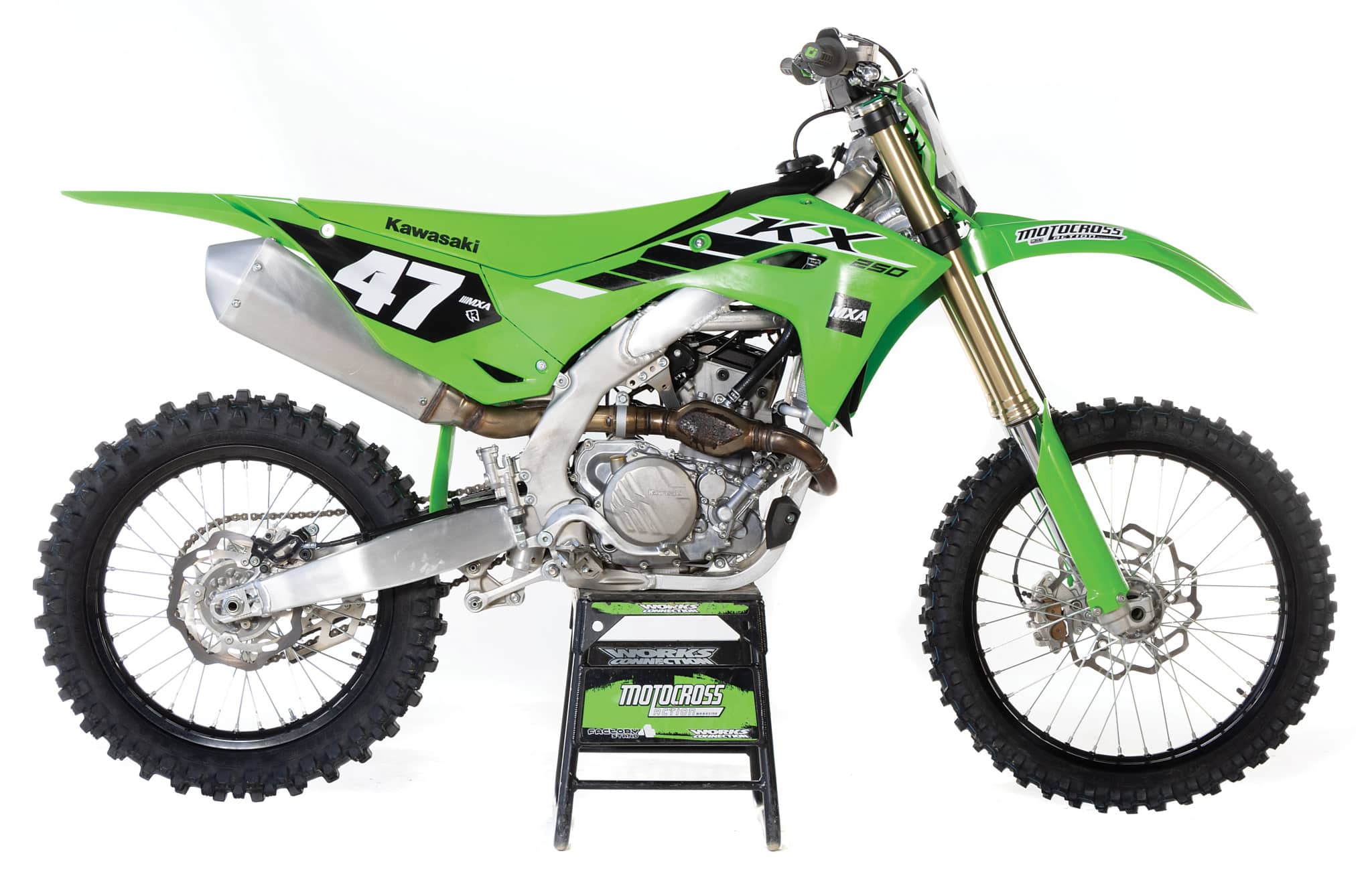 With a brand-new frame and an updated engine, the KX250 is considered an all-new bike for 2025.
With a brand-new frame and an updated engine, the KX250 is considered an all-new bike for 2025.
Q: WHAT’S NEW ABOUT THE 2025 KAWASAKI KX250 ENGINE?
A: Our test riders praised the 2024 KX250 for its big horsepower numbers and high-revving powerband, but felt that it needed more bottom-end grunt to help it transition to its high-rpm sweet spot. For 2025, Kawasaki took swings at improving low-rpm power, but whiffed a few times. Here’s a list of the changes they made.
(1) Intake. Kawasaki followed in Honda’s footsteps by reconfiguring the air boot to go over the top of the shock. This made for a steeper and straighter downdraft approach for air and fuel going into the combustion chamber.
(2) Throttle body. Accommodating the air and fuel is a larger 44mm throttle body with a new layout to align the intake and exhaust ports.
(3) Valves. The 31mm intake valves are one degree narrower.
(4) Camshafts. The intake camshaft was moved upward by 10mm to make room for the new downdraft intake position.
(5) Exhaust. The new center-port exhaust position exits through the front of the frame instead of out the side like last year’s exhaust. The head pipe aligns with the intake to straighten out airflow through the engine for more efficient fuel flow. Also, last year’s head pipe stuck out on the right side of the frame like a sore thumb. For 2025, the pipe travels straight forward before curving back. This allows the tuned length to be the same while tucking the head pipe in closer to the frame. Additionally, the muffler is moved 50mm forward for improved mass centralization and aesthetics.
(6) Spark plug. The new spark plug is 7.5mm longer to improve cooling to help prevent engine knocking.
(7) Piston. The new piston crown is one degree flatter at the top to accommodate the narrower valve angle. Additionally, material was removed from the underside of the piston for optimized balance and rigidity.
(8) Cylinder. The cylinder was moved five degrees forward on the cases to suit the new intake and exhaust layout.
(9) Compression. The compression ratio was reduced from 14.1:1 to 14.0:1.
(10) Balance shaft. The new single-shaft primary engine balancer was added to improve throttle response and create a smoother power delivery.
(11) E-start. The electric starter button has been reinforced to prevent water damage. The electric starter also has a new, high-torque motor to improve starting reliability.
(12) Mapping. It comes with new mapping and the ability to customize maps with the KX Rideology smartphone tuning app.
Q: HOW DOES THE 2025 KAWASAKI KX250 RUN ON THE DYNO?
A: Unfortunately for the 2025 KX250, Kawasaki’s engine R&D efforts didn’t pay off on the dyno. The dyno confirmed our test rider’s on-track opinion about the 2025 KX250 engine. From 6500 rpm and up, the new engine was slower than the 2024 KX250 engine at every point on the dyno curve. It’s 1 horsepower weaker at 7000 rpm; a 1/2 horsepower down at 8000 rpm; just over 1 horsepower lower at 9000 rpm; 2 horsepower off at 10,000 rpm; 1 horsepower slower at 11,000 rpm; a 1/2 horsepower weaker at 12,000 rpm; and, finally, the 2025 model drops off big time after it peaks at 12,500 rpm (for comparison, the 2024 KX250 continued to get stronger until it peaked at 13,300 rpm).
The 2025 KX250 peaks with 43.7 horsepower at 12,500 rpm and 20.48 pound-feet of torque at 9200 rpm, while the 2024 KX250 peaked with 45.11 horsepower at 13,300 rpm and 21.0 pound-feet of torque at 9000 rpm.
As always, a dyno isn’t the end-all, be-all of engine performance. After all, dynos don’t suit up and ride the bike for you; they are simply a tool of measurement that can be used to confirm what the test riders feel on the track. A great example is our 2025 Honda CRF250 Works Edition test (see page 38). That bike feels better than stock on the track, but it’s also slightly down on the dyno.
Q: HOW DOES THE 2025 KAWASAKI KX250 RUN ON THE TRACK?
A: The lower 2025 Kawasaki KX250 dyno numbers didn’t take our test riders by surprise. The new KX250 engine makes the bike feel heavy. You have to abuse the hydraulic clutch to get this bike moving forward. If you don’t spend extra energy riding the clutch, you’ll struggle to get the most out of the whole bike on the track. A stronger and friendlier engine would make it easier to wheelie over bumps and avoid the choppy stuff coming out of corners. A slower four-stroke engine requires more work to get going, making it harder to attack smoother lines. Every MXA test rider felt the KX250 was hard to shift and didn’t like to be shifted under a load. Of course, it was nowhere near as bad as the notchy shifting on the 2024 Triumph TF250-X, but it wasn’t as smooth as the Austrian 250Fs.
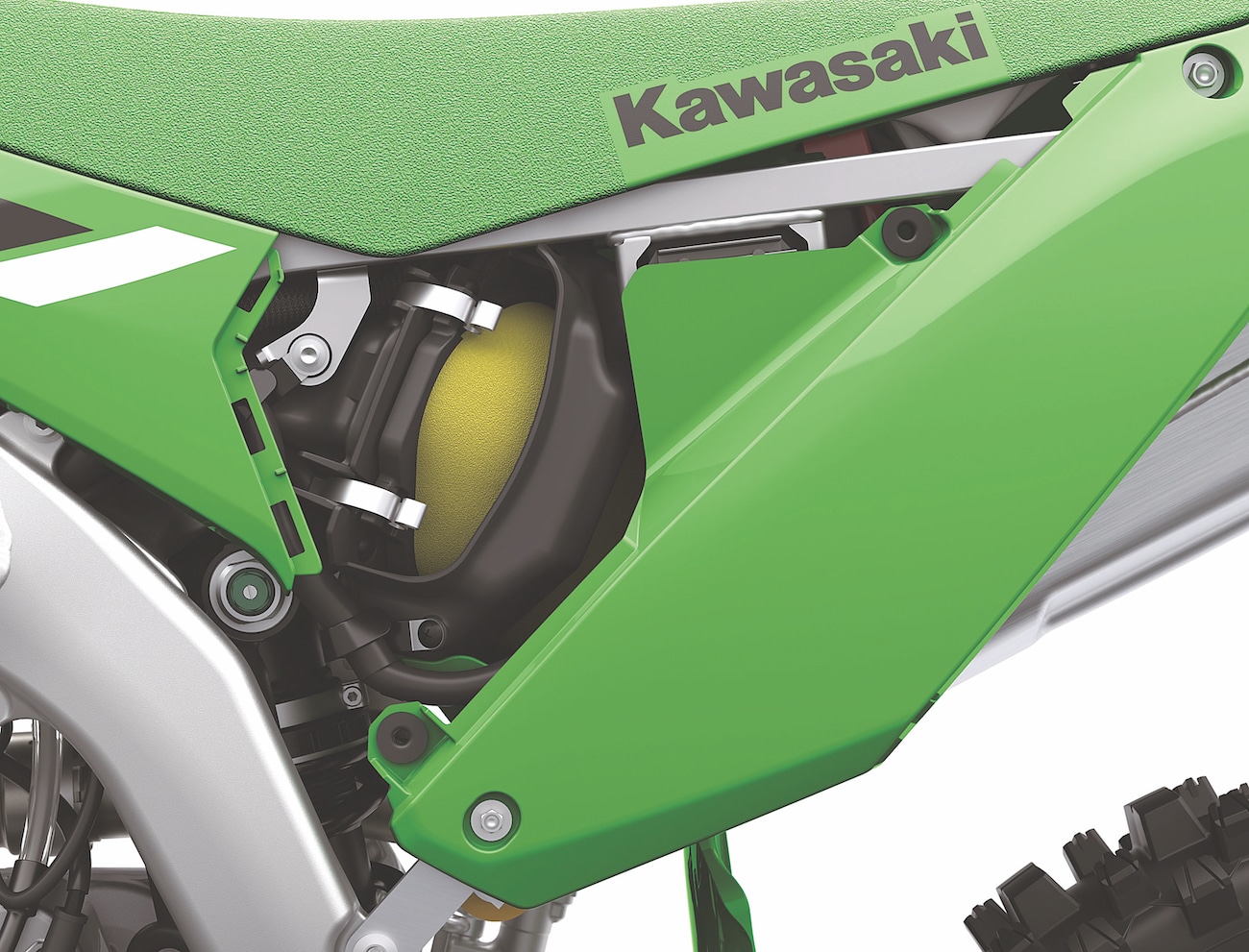 The KX250 air filter has a lot of issues. It cramped in the airbox, which means that it doesn’t breathe as well as it should.
The KX250 air filter has a lot of issues. It cramped in the airbox, which means that it doesn’t breathe as well as it should.
In a strange way, these complaints about the KX250 engine mimic the complaints we had about the 2024 KX450. To solve the issues with the 2024 KX450, Kawasaki replaced the flat filter with a domed filter on the 2024 KX450 and the new KX250. On the KX450, we recommended replacing the stock air filter setup with Twin Air’s Powerflow kit (only the base plate is different, and it will require a different part number from Twin Air). It takes some effort to install the Powerflow kit because you have to attach Twin Air’s proprietary baseplate to the stock airbox, but it does improve airflow, and, most important, it improves sealing for the filter with two grommets locking the filter in place. We also suggest cutting out all the excess plastic Kawasaki installed around the filter. It was all meant to reduce noise by limiting airflow, which also lowers throttle response and overall power.
While riding the stock 2024 and 2025 KX250s back to back, our test riders had to drop down to first gear in some of the tighter corners on the 2025 model, while they could easily pull second gear in tight corners on the ’24 bike.
As one test rider wrote in his test report, “The 2024 KX250 wants you to go faster, while the 2025 model doesn’t. The 2025 power window is narrow, but if you can find it, the bike actually feels fast, but the engine has no recovery. As soon as you make a mistake or don’t push 100 percent through a corner, it falls on its face. Compared to last year’s bike, it’s as if the rear brake is dragging.” On last year’s KX250, the engine was the highlight and our complaints focused on the chassis; now our opinion has flip-flopped.
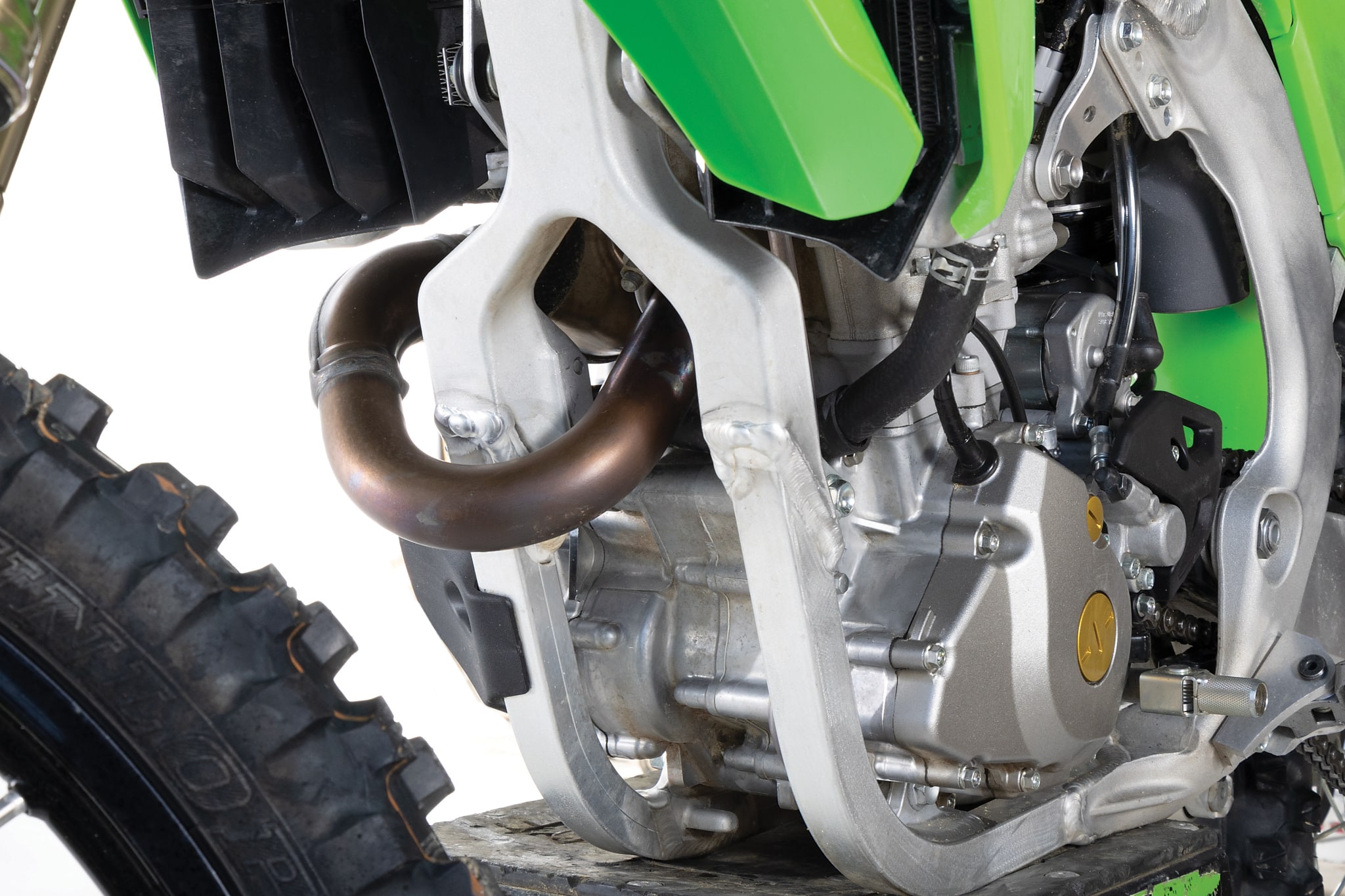 A new feature for the 2025 KX250 engine and frame is the center-port exhaust layout.
A new feature for the 2025 KX250 engine and frame is the center-port exhaust layout.
Q: HOW IS THE 2025 KAWASAKI KX250 SUSPENSION?
A: Our loudest complaints about the 2024 KX250 were regarding the suspension, largely because the 2024 Kayaba setup came stock with Supercross-stiff fork-spring forks. Interestingly enough, Kawasaki had always spec’d Showa suspension on the KX450, but switched from Showa to Kayaba suspension on their 250s starting in 2020. After five years with the Kayaba setup on the KX250, Kawasaki consolidated its suspension ordering for 2025 by using Showa components on both bikes. Considering that the Kayaba forks were no great shakes on the KX250 over the last few years, the switch to Showa makes sense. Plus, to accommodate the new downdraft intake setup going over the top of the shock, Showa had already supplied a new 32mm-shorter shock for the 2024–2025 KX450. While the stroke remained the same, the shock’s reservoir was moved to the left side of the bike to allow more room for the exhaust. Rather than paying for Kayaba to design a new shock, the logical choice was to switch to the already existing Showa shock. On a side note, the factory-backed Pro Circuit Kawasaki team has always run Showa components.
How does the suspension work on the track? First off, it is much better than last year. However, it is not amazing, just an improvement. The forks are soft, which causes them to ride low in the stroke and feel harsh for heavier and faster riders. Still, we’ll take the softer 2025 Showa forks over the ultra-rigid 2024 Kayaba forks any day. With forks that actually want to move, our test riders felt more comfortable at corner entrance and found it easier to find the right line on corner exit. It is the same chassis as on the KX450, which has a 1-degree steeper head angle.Once you find comfort with the 2025 KX250’s forks, the bike is much easier to turn but slightly less stable at speed. Thankfully, stability wasn’t a glaring issue for our test riders.
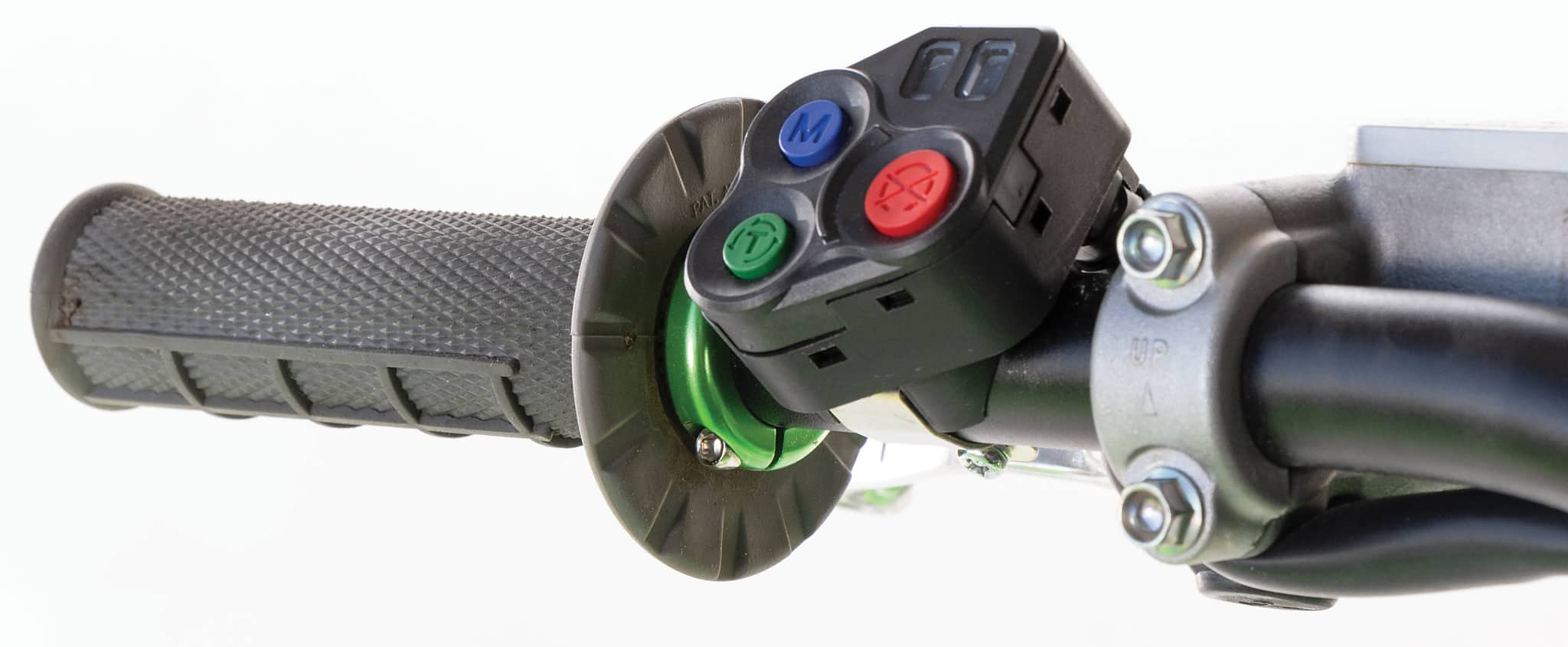 The KX250 electronic suite should look familiar, it’s a clone of the Honda switchgear.
The KX250 electronic suite should look familiar, it’s a clone of the Honda switchgear.
Q: WHAT DID WE HATE?
A: The hate list.
(1) Weight. The KX250 is the heaviest 250 four-stroke on the market at 232 pounds. That’s 5 pounds heavier than the Suzuki RM-Z250 and 11 pounds heavier than the Triumph TF250-X.
(2) Levers. While the KX450 gained a Brembo front brake, the KX250 stayed with the old-school Nissin front and rear brakes. The oddly shaped brake levers are still an irritant.
(3) Rear brake. In addition to our lever complaint, the test riders felt the 240mm Nissin rear brake rotor was too hard to modulate. It locked up easily and upset the chassis with accidental brake slides.
(4) Plastics. Kawasaki plastic is still brittle. Make sure to put graphics on your front number plate and fork guards or they will crack from roost.
(5) Bolts. The steel bolt that threads into the aluminum subframe to hold the airbox cover on still strips out easier than any bolt on any other brand.
(6) T-plate. If the T-plate holding the seat onto the rear fender falls out, replace it with Bolt Hardware’s replacement T-plate, which is sure to stay in place.
(7) Radiator cap. Kawasaki replaced the stock 1.1 kg/mm2 radiator cap with a 1.8 kg/mm2 cap before they even gave us the bike. You should replace yours, too.
(8) Vibration. Kawasaki’s engineers said they made changes to reduce vibration, but the KX250 still vibrates more than any other 250 four-stroke.
(9) Bar mounts. The bar mounts still twist easily. Switch them to Luxon MX bar mounts.
(10) Engine. It’s slower than last year; that’s not good.
(11) Mapping. The KX Rideology app designers need to take notes from Yamaha. Their app won’t even tell you how many hours you have on the engine.
(12) Airbox. It’s too choked up, and the filter is scary to slide into place. We’re always worried about dirt falling in.
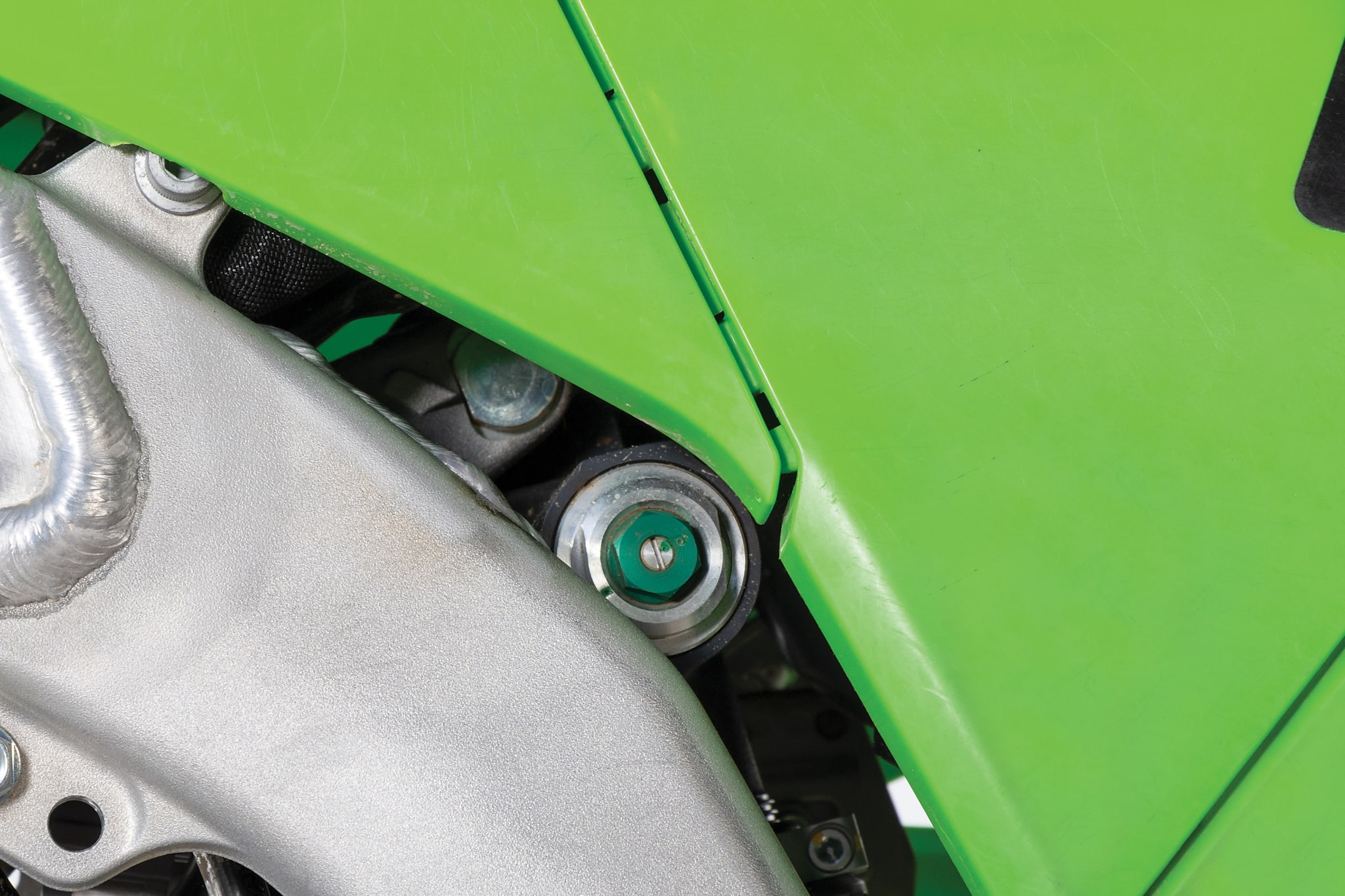 The KX250 rear shock is in there somewhere.
The KX250 rear shock is in there somewhere.
Q: WHAT DID WE LIKE?
A: The like list.
(1) Chain buffer. Thankfully, Kawasaki replaced the unreliable bottom chain roller with a KTM-copy chain buffer pad.
(2) Tires. We like that it comes stock with the latest and greatest Dunlop MX34 tires with an 80/100-21 front and 110/90-19 rear.
(3) Footpegs. Kawasaki offers an extra footpeg mounting hole to lower the pegs 5mm for taller riders.
(4) Suspension. The switch from Kayaba to Showa paid off.
(5) Plastics. The new KX250 plastics offer a solid contact patch for gripping the bike.
(6) ODI. We love the stock ODI lock-on grips.
(7) Bar mounts. We don’t like how easily they twist, but it’s nice to have two mounting holes and the ability to turn the mounts forward or rearward, creating four different bar positions for customizing the cockpit.
(8) Team Green. Ride green, earn green. One of the big reasons so many riders choose Kawasaki is their generous contingency program. They pay great money for motocross and off-road racing, with over 19 million dollars up for grabs for all Kawasaki riders on eligible models.
(9) Price. With an MSRP of $8999, it’s much more affordable than the European brands.
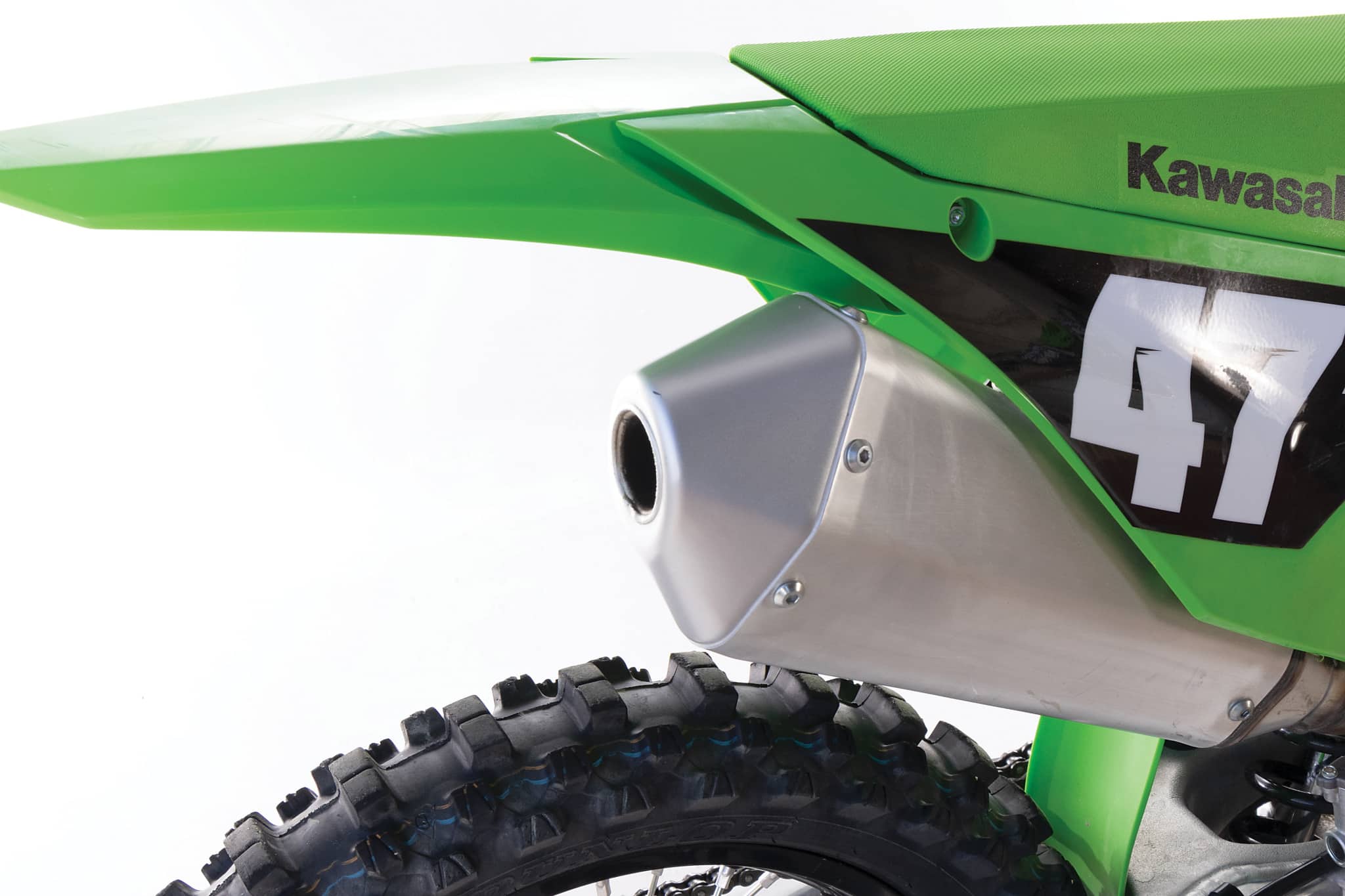 The muffler has been moved 50mm farther forward with an all-new tapered cannister.
The muffler has been moved 50mm farther forward with an all-new tapered cannister.
Q: WHAT DID WE REALLY THINK?
A: Last year, we said, “The 250 class is all about horsepower, so we must applaud Kawasaki for its pony-producing efforts; however, the 2024 Kawasaki KX250 has a governor on it, and the governor is the frame and the Supercross-stiff Kayaba forks.”
This year, Kawasaki took two steps forward in the chassis department and one step backward in the engine department. Novice and vet test riders preferred the 2025 KX250 over the 2024 model because of its more comfortable suspension, improved cornering and overall friendlier handling characteristics. Our intermediate-and-up test riders preferred the 2024 model for its stronger, higher-revving, 45.11-horsepower engine, because they knew they could fix the too-stiff forks and work with the difficult-to-turn chassis. In conclusion, the 2025 Kawasaki KX250 is better than before for a wide range of riders, but it’s not all we hoped it would be.
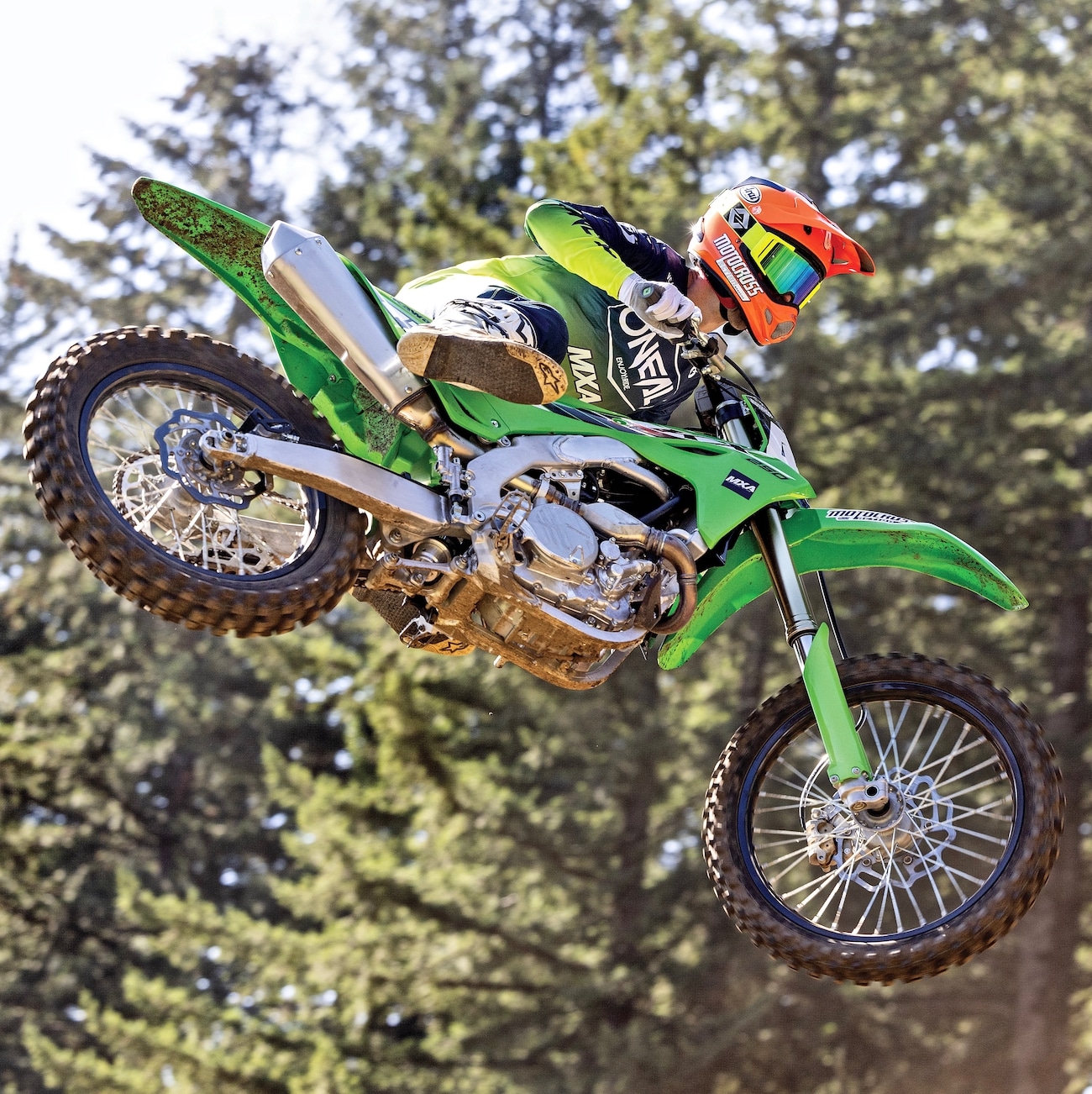 Last year we loved the powerplant and hated the chassis, this year we love the chassis and hate the powerband.
Last year we loved the powerplant and hated the chassis, this year we love the chassis and hate the powerband.
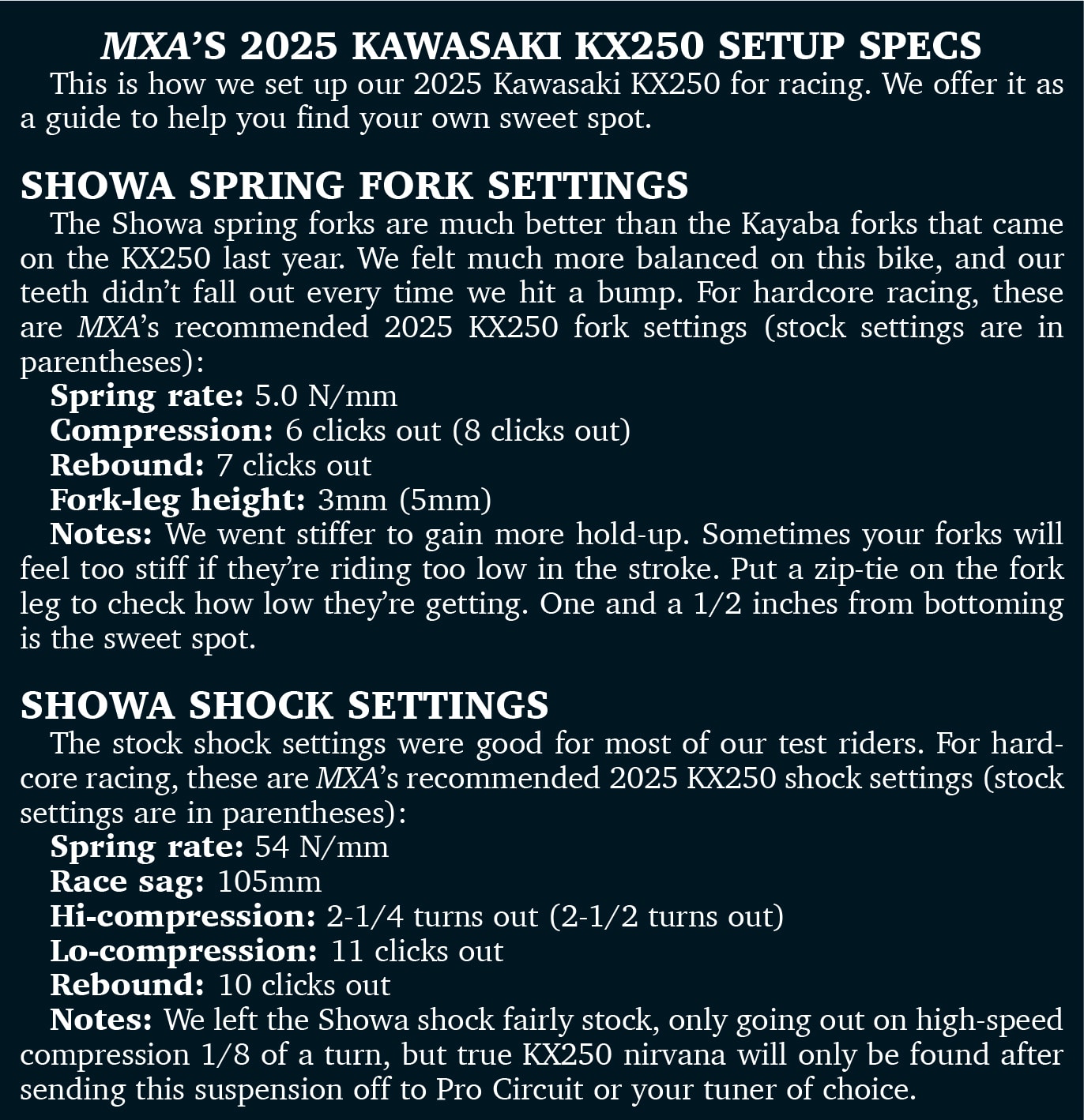


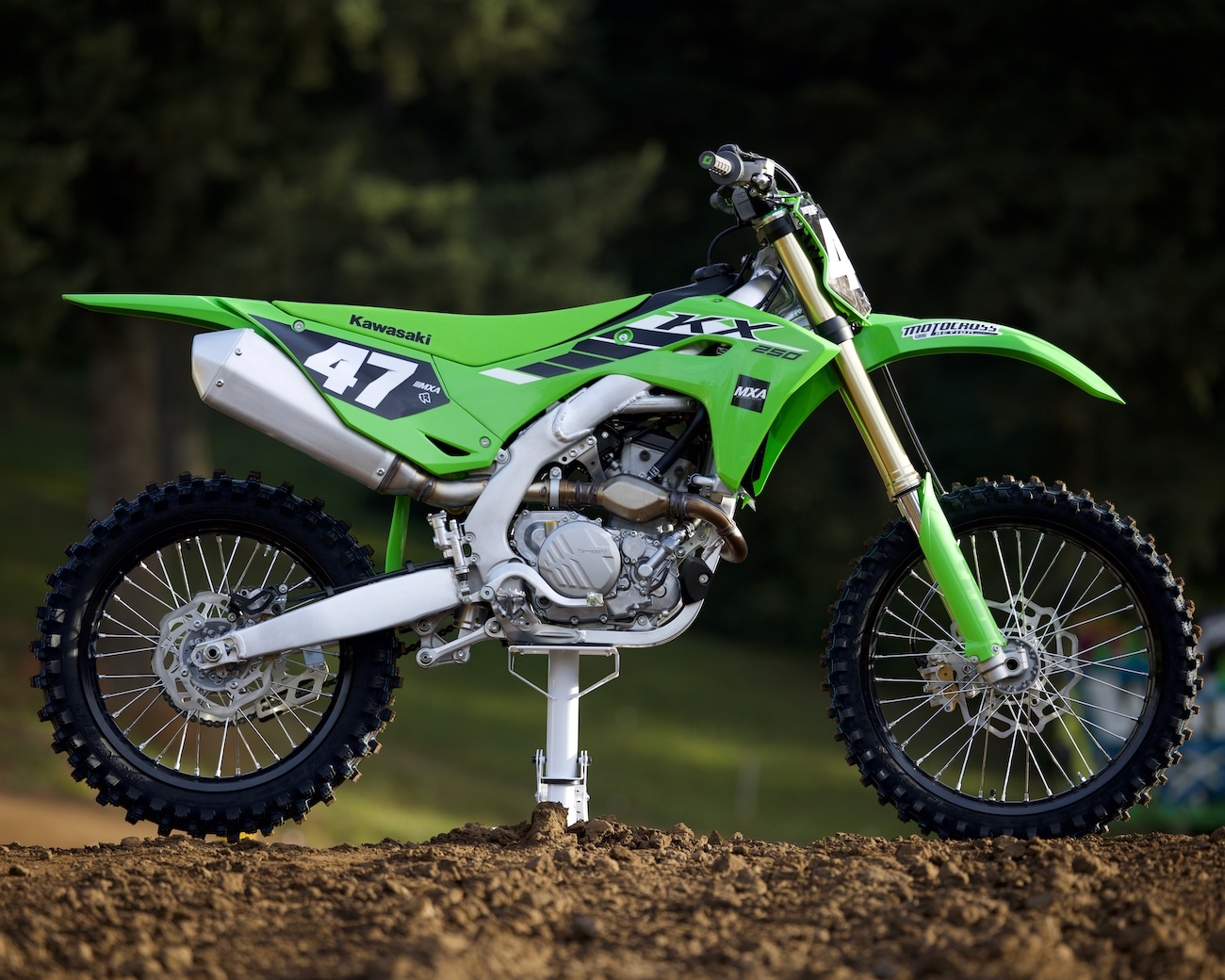
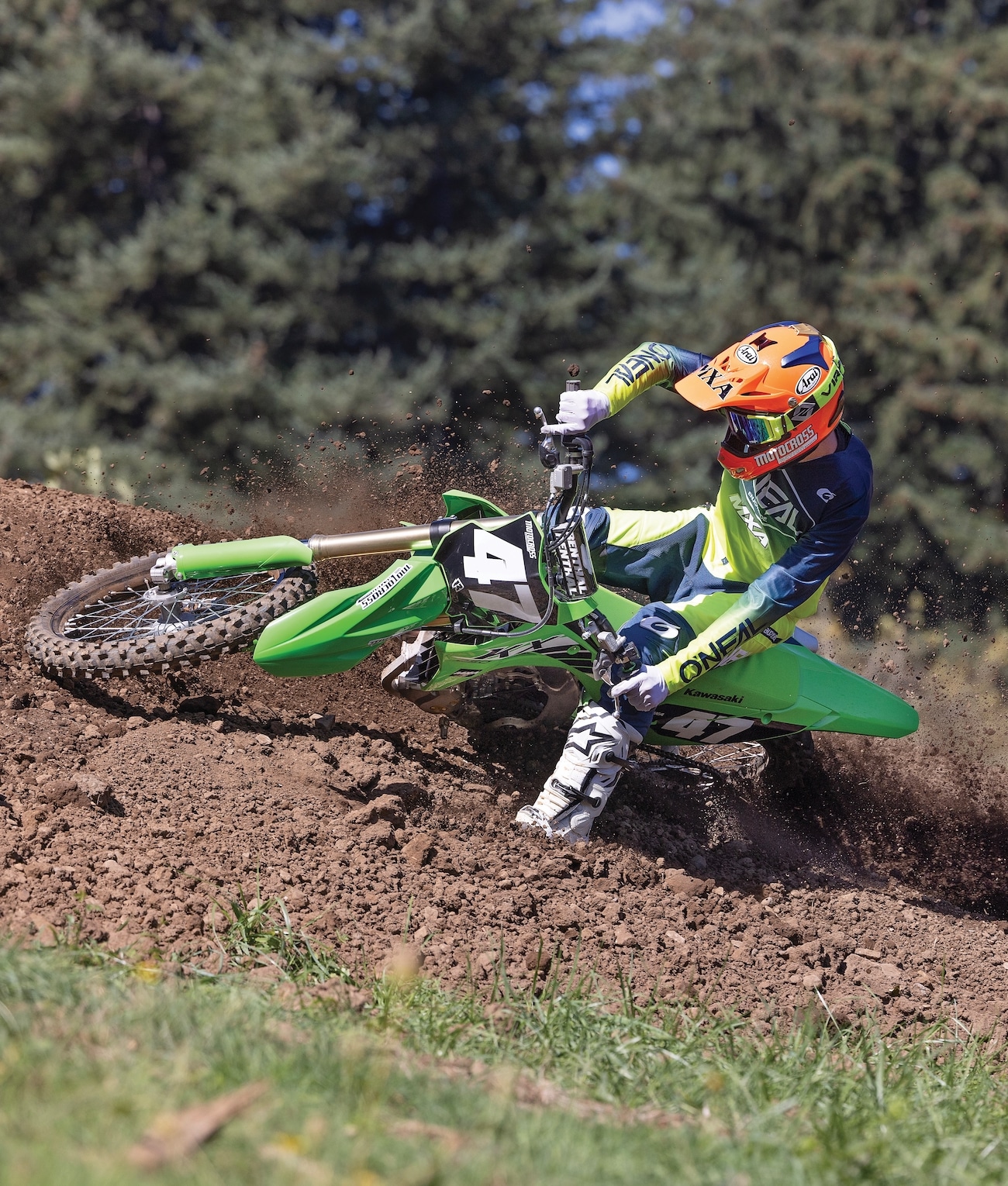
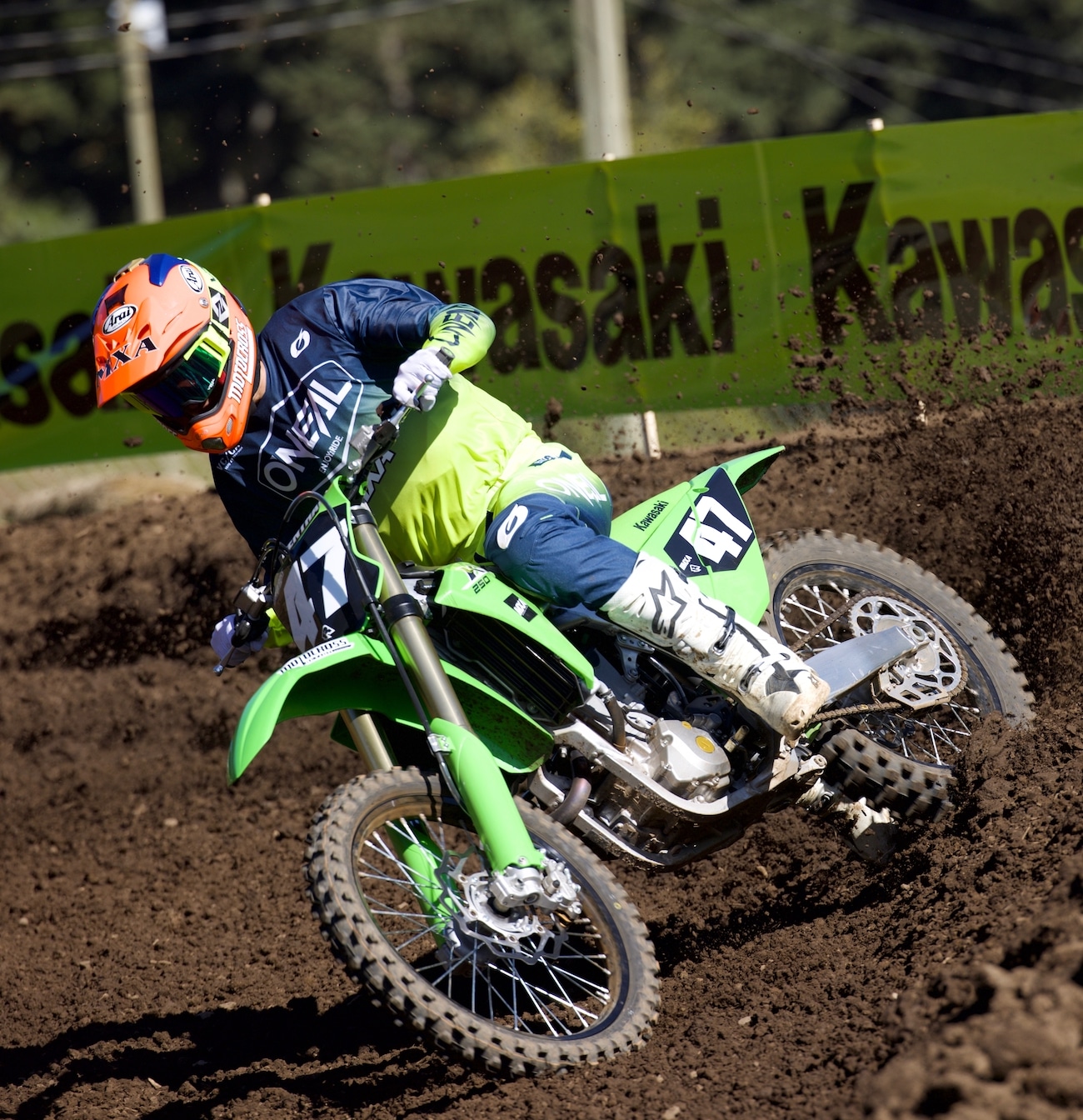

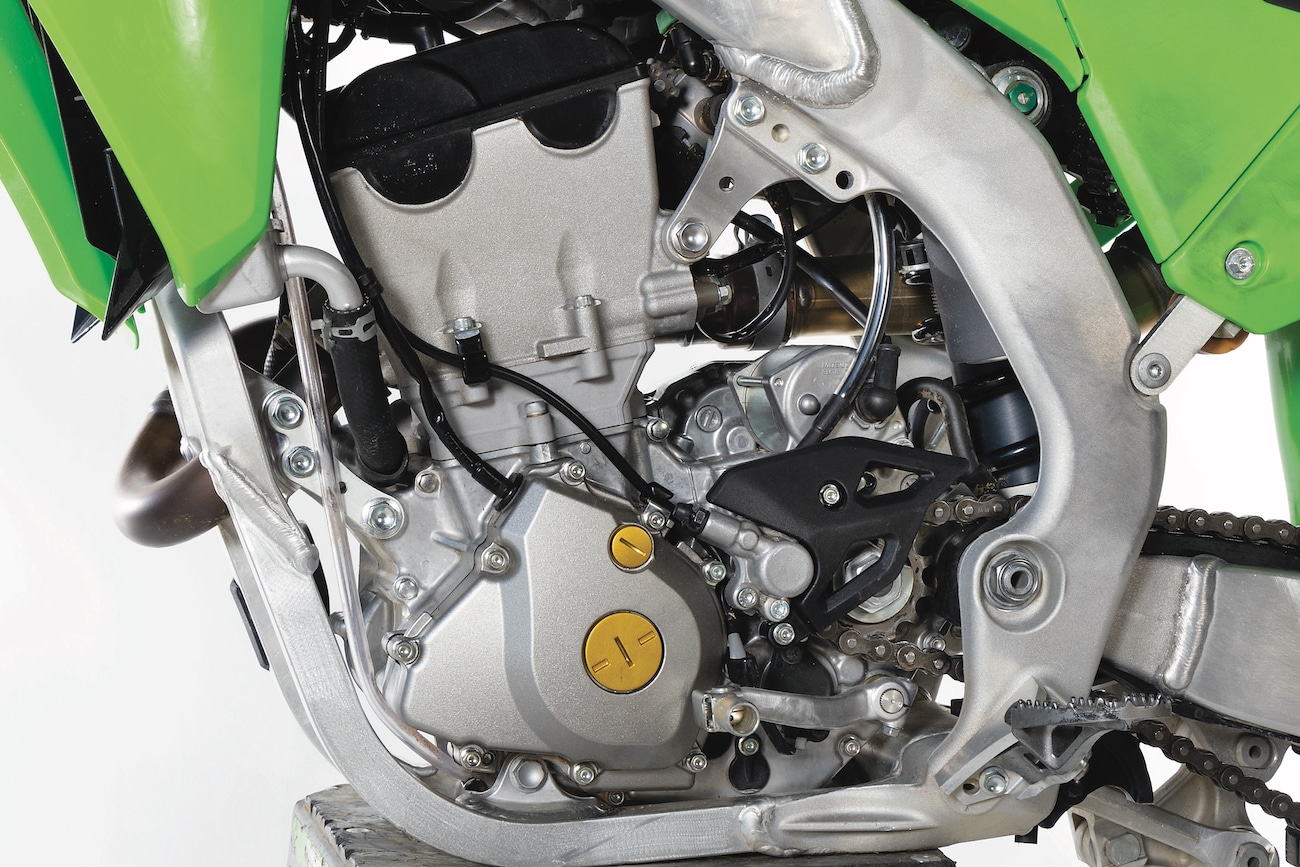



Comments are closed.